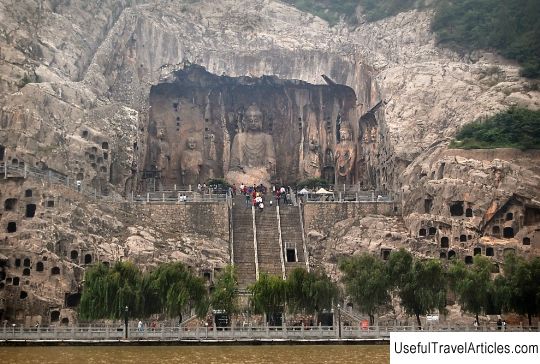Longmen Buddhist Cave Temple in China
Rating: 8,4/10 (8755 votes)  Longmen is a complex of Buddhist temples in caves, which is located in Henan province, 12 kilometers south of Luoyang. These caves are located on the slopes of Longmenshan and Xianshan mountains, on either side of a small river. According to official data, there are about 2345 grottoes with 43 temples. The temples contain more than 100 thousand religious images and about 2 800 inscriptions. Temples began to be built back in 493 during the Northern Wei Dynasty, but about 60% of the statues can be attributed to the Tang Dynasty, that is, to the 7-9 century. Guyang Cave is one of the oldest caves complex. It was built in 428-488. It displays images of members of the emperor's family and aristocrats from the Northern Wei Dynasty. Three rows of Buddha statues of different sizes are carved into the south and north walls. The statues have stylized heads and elongated necks, typical of the Wei style. The Lausanne Buddha is located in FengXian Temple. It was created by Emperor Gao Zong. The height of the statue is 17 meters, the height of its head is 4 meters, and the length of the ears is 2 meters. The only Chinese empress, Wu Zetian, devoted a large portion of her budget to special cosmetics to complete the statue. It is believed that the statue looks a bit like an empress. Adjacent to it are 6 other statues, and together they are considered the most expertly executed Buddhist sculptural images. They contrast sharply with the motionless and heavy statues of Wei with their elegantly depicted clothing, lithe bodies, and lively expressions. The Thousand Buddha Cave is another masterpiece of the Tang Dynasty. It was built in 680. The central Buddha, with a calm expression, sits on a lotus throne supported by strong and healthy vajras. Behind this statue are 54 lotuses with Bodhisattvas sitting on them. And the northern and southern parts are covered with 15 thousand miniature images of Buddha. The cave is protected by a metal fence. The main significance of this temple complex is that it shows the completion of the process of adoption in China of the Indian Buddhist temple-cave culture. Also, this complex serves as a reflection of social culture, economics and politics of those times. Through the Longmen cave temples, we can learn more about the art, religion, calligraphy, architecture, medicine and clothing of those eras. We also recommend reading Dazu rock carvings in China Topic: Longmen Buddhist Cave Temple in China. |




